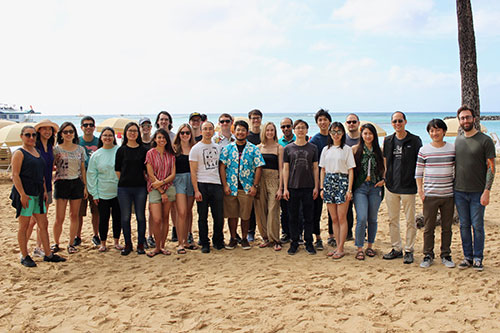Christopher Chang

Class of 1942 Chair and Professor of Molecular Therapeutics*
*And of Chemistry
Research Interests
Chemical Biology: Imaging and Proteomics to Decipher and Drug Novel Metal and Redox Disease Vulnerabilities
Our laboratory works in the area of chemical biology, where we advance new concepts in imaging, proteomics, drug discovery, and catalysis. For example, we have developed activity-based sensing as a general platform to identify transition metals, reactive oxygen species, and one-carbon units as new classes of single-atom signals for allosteric regulation of protein function. These chemical tools also reveal unique metal and redox disease vulnerabilities as targets for innovative drug discovery efforts to treat neurodegeneration, cancer, and metabolic disorders. Our work in artificial photosynthesis addresses global challenges in climate change. We use design concepts from biology to develop molecular electrocatalysts for carbon dioxide capture and conversion and nitrogen/phosphorus cycling. Representative project areas are summarized below.
Current Projects

The Chang Lab, 2020
Transition Metal Signaling and Metalloallostery: Bioinorganic Chemistry Beyond Active Sites. We are advancing a new paradigm of transition metal signaling, where metal nutrients like copper and iron can serve as dynamic signals to regulate protein function by metalloallostery, going beyond their traditional roles as static active site cofactors. We develop activity-based sensing probes for imaging mobile transition metal pools and activity-based proteomics probes for identifying allosteric metal sites in proteins. These chemical tools enable us to decipher the complex biology of sleep, cognition, and obesity in cell, zebrafish, and mouse models. We also develop medicines to target metals as disease vulnerabilities in cancer, neurodegeneration, and metabolic liver disorders. These drug discovery efforts focus on cuproplasia and cuproptosis, newly recognized forms of copper-dependent cell proliferation and cell death, respectively.
Activity-Based Sensing: Leveraging Selective Chemistry to Decipher New Redox and One-Carbon Biology. We have pioneered the field of activity-based sensing, where we develop chemical sensors for biological analytes that achieve high selectivity using reaction chemistry rather than conventional lock-and-key binding approaches. By applying these chemical tools to enable real-time imaging of reactive oxygen species and one-carbon metabolites at the single-cell, tissue, and animal level, we elucidate principles of how these molecular signals influence fundamental biological processes spanning epigenetics to immune response.
Activity-Based Proteomics: Bioconjugation Chemistry for Single-Atom Signaling and Redox Drug Discovery. We are establishing the area of single-atom signaling, focusing on the study of reversible interconversion of methionine and methionine sulfoxide sites in proteins by adding or removing a single oxygen atom. We develop activity-based proteomics probes to identify new targets of methionine modification as well as writers and erasers that regulate their single-atom biology. These chemical tools also reveal new ligandable hotspots for undruggable protein targets and pathways to accelerate the development of next-generation precision medicines that target redox disease vulnerabilities in cancer and neurodegeneration.
Artificial Photosynthesis: Catalyzing Sustainable Electrosynthesis. We develop catalysts for sustainable electrosynthesis to address climate change and rising global energy demands. Inspired by natural photosynthesis, which produces the value-added products needed to sustain life from light, water, and carbon dioxide, we use biological design principles to create synthetic molecular electrocatalysts for carbon dioxide capture and conversion as well as nitrogen/phosphorus cycling.
Selected Publications
1. "Searching for Harmony in Transition-Metal Signaling", Chang, C. J. Nature Chem. Biol. 2015, 111, 744-747.
2. "Connecting copper and cancer: from transition metal signalling to metalloplasia", Ge, E. J.; Bush, A. I.; Casini, A.; Cobine, P. A.; Cross, J. R.; DeNicola, G. M.; Dou, Q. P.; Franz, K. J.; Gohil, V. M.; Gupta, S.; Kaler, S. G.; Lutsenko, S.; Mittal, V.; Petris, M. J.; Polishchuk, R.; Ralle, M.; Schilsky, M. L.; Tonks, N. K.; Vahdat, L. T.; Aelst, L. V.; Xi, D.; Yuan, P.; Brady, D. C.; Chang, C. J. Nature Rev. Cancer 2022, 22, 102.
3. "Copper regulates cyclic-AMP-dependent lipolysis", Krishnamoorthy, L.; Cotruvo Jr., J. A.; Chan, J.; Kaluarachchi, H.; Muchenditsi, A.; Pendyala, V. S.; Jia, S.; Aron, A. T.; Ackerman, C. M.; Wander Wal, M. N.; Guan, T.; Smaga, L. P.; Farhi, S. L.; New, E. J.; Lutsenko, S.; Chang, C. J. Nature Chem. Biol. 2016, 12, 586-593.
4. "Copper regulates rest-activity cycles through the locus coeruleus-norepinephrine system", Xiao, T.; Ackerman, C. M.; Carroll, E. C.; Jia, S.; Hoagland, A.; Chan, J.; Thai. B.; Liu, C. S.; Isacoff, E. Y.; Chang, C. J. Nature Chem. Biol. 2018, 14, 655-663.
5. "Oxidation state-specific fluorescent copper sensors reveal oncogene-driven redox changes that regulate labile copper(II) pools", Pezacki, A. T.; Matier, C. D.; Gu, X,; Kummelstedt, E.; Bond, S. E.; Torrente, L; Jordan-Sciutto, K. L.; DeNicola, G. M.; Su, T. A.; Brady, D. C.; Chang, C. J. PNAS 2022, 119, e2202736119.
6. "Redox-based reagents for chemoselective methionine bioconjugation", Lin, S.; Yang, X.; Jia, S.; Weeks, A. M.; Hornsby, M.; Lee, P. S.; Nichiporuk, R. V.; Iavarone, A. T.; Wells, J. A.; Toste, F. D.; Chang, C. J. Science 2017, 355, 597-602.
7. "Methionine oxidation activates pyruvate kinase M2 to promote pancreatic cancer metastasis", He, D.; Feng, H.; Sundberg, B.; Yang, J.; Powers, J.; Christian, A. H.; Wilkinson, J. E.; Monnin, C.; Avizonis, D.; Thomas, C. J.; Freidman, R. A.; Kluger M. D.; Hollingsworth, M. A.; Grandgenett, P. M.; Klute, K. A.; Toste, D. F.; Chang, C. J; Chio, I. I. C. Mol. Cell 2022, 82, 3045-3060.e11.
Last Updated 2023-01-05